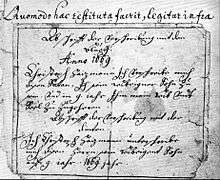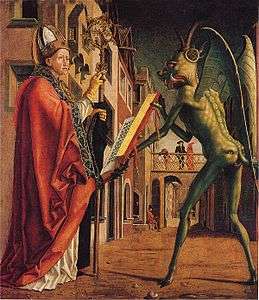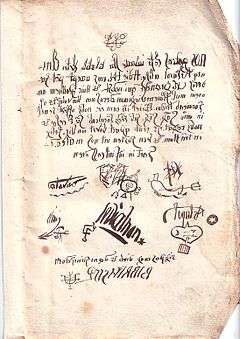Deal with the Devil

A deal with the devil, compact or pact with the devil is a cultural motif, best exemplified by the legend of Faust and the figure of Mephistopheles, but elemental to many Christian folktales. According to traditional Christian belief in witchcraft, the pact is between a person and Satan or a lesser demon. The person offers his or her soul in exchange for diabolical favours. Those favours vary by the tale, but tend to include youth, knowledge, wealth, fame, or power.
It was also believed that some persons made this type of pact just as a sign of recognizing the devil as their master, in exchange for nothing. Nevertheless, the bargain is considered a dangerous one, as the price of the Fiend's service is the wagerer's soul. The tale may have a moralizing end, with eternal damnation for the foolhardy venturer. Conversely, it may have a comic twist, in which a wily peasant outwits the devil, characteristically on a technical point. The person making the pact sometimes tries to outwit the devil, but loses in the end (e.g., man sells his soul for eternal life because he will never die to pay his end of the bargain. Immune to the death penalty, he commits murder, but is sentenced to life in prison).
Great achievements might be credited to a pact with the devil, from the numerous European Devil's Bridges to the violin virtuosity of Niccolò Paganini to the "crossroad" myth associated with Robert Johnson.
The "Bargain with the devil" constitutes motif number M210 and "Man sells soul to devil" motif number M211 in Stith Thompson's Motif-Index of Folk-Literature.[1]
Synopsis

It was usually thought that the person who had made a pact also promised the demon to kill children or consecrate them to the devil at the moment of birth (many midwives were accused of this, due to the number of children who died at birth in the Middle Ages and Renaissance), take part in Sabbaths, have sexual relations with demons, and sometimes engender children from a succubus, or an incubus in the case of women.
The pact can be oral or written. An oral pact is made by means of invocations, conjurations, or rituals to attract the demon; once the conjurer thinks the demon is present, he/she asks for the wanted favour and offers his/her soul in exchange, and no evidence is left of the pact; but according to some witch trials and inquisitions that were performed, even the oral pact left evidence, namely the diabolical mark, an indelible mark where the marked person had been touched by the devil to seal the pact. The mark could be used as a proof to determine that the pact was made. It was also believed that on the spot where the mark was left, the marked person could feel no pain. A written pact consists in the same forms of attracting the demon, but includes a written act, usually signed with the conjurer's blood (although sometimes was also alleged that the whole act had to be written with blood, meanwhile some demonologists defended the idea of using red ink instead of blood and others suggested the use of animal blood instead of human blood).[2] Forms of these include contracts or simply signing your name into Satan's Red Book.
These acts were presented often as a proof of diabolical pacts, though critics claim there is no proof of whether they were authentic, written by insane persons believing they were actually dealing with a demon, or just were fake acts presented by the tribunals of the Inquisition. Usually the acts included strange characters that were said to be the signature of a demon, and each one had his own signature or seal. Books like The Lesser Key of Solomon (also known as Lemegeton Clavicula Salomonis) give a detailed list of these signs, known as diabolical signatures.
The Malleus Maleficarum discusses several alleged instances of pacts with the Devil, especially concerning women. It was considered that all witches and warlocks had made a pact with some demon, especially with Satan.
According to demonology, there is a specific month, day of the week, and hour to call each demon, so the invocation for a pact has to be done at the right time. Also, as each demon has a specific function, a certain demon is invoked depending on what the conjurer is going to ask.
In the narrative of the Synoptic Gospels, Jesus is offered a series of bargains by the devil, in which he is promised worldly riches and glory in exchange for serving the devil rather than God. After Jesus rejects the devil's offers, he embarks on his travels as the Messiah[3] (see Temptations of Christ).
Theophilus of Adana, servant of two masters
The predecessor of Faustus in Christian mythology is Theophilus ("Friend of God" or "Beloved of god") the unhappy and despairing cleric, disappointed in his worldly career by his bishop, who sells his soul to the devil but is redeemed by the Virgin Mary.[4] His story appears in a Greek version of the sixth century written by a "Eutychianus" who claims to have been a member of the household in question.
A ninth-century Miraculum Sancte Marie de Theophilo penitente inserts a Virgin as intermediary with diabolus, his "patron", providing the prototype of a closely linked series in the Latin literature of the West.[5]
In the tenth century, the poet nun Hroswitha of Gandersheim adapted the text of Paulus Diaconus for a narrative poem that elaborates Theophilus' essential goodness and internalizes the seduction of good and evil, in which the devil is magus, a necromancer. As in her model, Theophilus receives back his contract from the devil, displays it to the congregation, and soon dies.
A long poem on the subject by Gautier de Coincy (1177/8–1236), entitled Le miracle de Théophile: ou comment Théophile vint à la pénitence provided material for a thirteenth-century play by Rutebeuf, Le Miracle de Théophile, where Theophilus is the central pivot in a frieze of five characters, the Virgin and the bishop flanking him on the side of good, the Jew and the devil on the side of evil.
Alleged diabolical pacts in history

Notable supposed deals with the devil were struck between the 15th and 18th centuries. The motif lives on among musicians until the 20th century.
- Johann Georg Faust (1466/80 - 1541), whose life was the origin of the Faust legend.[6]
- John Fian (executed on January 27, 1591), A Doctor and school teacher who was declared as a notorious sorcerer. He confessed to have a compact with Satan during the North Berwick witch trials in Scotland which he confessed to King James as the trial proceedings were taking place but later promised that he would renounce his compact with Satan and vow to lead the life of a Christian. The next morning, he confessed that the Devil came to him in his cell dressed in all black holding a white wand, demanding Fian continue his faithful service, according to his first oath and promise that he made. Fian testified that he renounced Satan to his face saying "Avoided Satan, avoided, for I have listened too much to thee, and by the same thou hast undone me, in respect whereof I utterly forsake you." He confessed that the devil then answered "That once ere thou die thou shall be mine." The devil afterwards broke the white wand, and immediately vanished from his sight. He then was given a chance to lead the life he promised but the same night he stole a key to his cell and escaped. He was eventually captured and tortured until his execution. [7]
- Urbain Grandier (1590 - 1634), seventeenth-century French priest, who was tried and burned at the stake for witchcraft. One of the documents presented at his trial was a diabolical pact he supposedly signed, which also bears what are supposed to be the seals of several demons, including that of Satan himself.
- Christoph Haizmann (1651/2 - 1700), seventeenth-century painter from Bavaria, allegedly signed two pacts to be a "bounden son" to the devil in 1668.[8]
- Jonathan Moulton (1726 - 1787), eighteenth-century brigadier general of the New Hampshire Militia, alleged to have sold his soul to the Devil to have his boots filled with gold coins when hung by the fireplace every month.
- Giuseppe Tartini (8 April 1692 – 26 February 1770), Venetian violinist and composer, who believed that his Devil's Trill Sonata was inspired by the Devil's appearance before him in a dream.[9]
- Niccolò Paganini (27 October 1782 – 27 May 1840), Italian violinist, who may not have started the rumour but played along with it.[10]
- Philippe Musard (1793 - 1859), French composer and more importantly orchestra leader, whose wild conducting and sensuous concerts generated the rumor while a celebrity in Paris in the 1830s.[11]
- Tommy Johnson (1896 – 1 November 1956), blues musician[12]
- Robert Johnson (8 May 1911 – 16 August 1938), blues musician, whom legend claims to have met Satan at a crossroads and signed over his soul to play the blues and gain mastery of the guitar.[12]
Metaphorical use of the term
The term "a pact with the devil" is also used metaphorically to condemn a person or persons perceived as having collaborated with an evil person or regime. An example of this is the still-controversial case of Rudolf Kastner in Israel, in which the term was used in reference to Kastner's collaboration with Adolf Eichmann during the Holocaust in 1944 Hungary. According to some, the term served to inflame public hatred against Kastner, culminating in his assassination.[13]
See also
| Wikimedia Commons has media related to Deal with the Devil. |
Notes
- ↑ Stith Thompson, Motif-Index of Folk-Literature, 2nd ed. (Bloomington: Indiana UP, 1955-58), vol. 5, pp. 39-40.
- ↑ William Godwin (1876). "Lives of the Necromancers". p. 16.
- ↑ Matthew 4:1-11; Mark 1:12-13; Luke 4:1-13
- ↑ Palmer, Phillip Mason; More, Robert Pattison (1936). The Sources of the Faust Tradition: From Simon Magus to Lessing. New York: Oxford University Press. OCLC 3444206.
- ↑ Representative examples of the Latin tradition were analysed by Moshe Lazar, "Theophilus: Servant of Two Masters. The Pre-Faustian Theme of Despair and Revolt" in Modern Language Notes 87.6, (Nathan Edelman Memorial Issue November 1972) pp. 31–50.
- ↑ Ruickbie, Leo (2009). Faustus: The Life and Times of a Renaissance Magician. The History Press. ISBN 978-0-7509-5090-9.
- ↑ King James. Daemonologie. A Critical Edition. In Modern English. 2016. p. 112-115. ISBN 1-5329-6891-4.
- ↑ Vandendriessche, Gaston (1965). The Parapraxis in the Haizmann Case of Sigmund Freud. Louvain: Publications Universitaires.
- ↑ Richter, Simon (18 July 2008). "Did Giuseppe Tartini Sell His Soul to the Devil?". University of Pennsylvania.
- ↑ Schonberg, Harold C. (1997). The Lives of the Great Composers (3rd ed.). Norton. ISBN 0-393-03857-2. OCLC 34356892.
- ↑ Hemmings, F. W. J. (1987). Culture and Society in France 1789 - 1848. London: Bloomsbury Reader. p. 394. ISBN 978 1 4482 0507 3.
- 1 2 Weissman, Dick (2005). Blues: The Basics. New York: Routledge. ISBN 0-415-97067-9. OCLC 56194839.
- ↑ Adam LeBor (23 August 2000). "Eichmann's List: a pact with the devil". The Independent. independent.co.uk. Retrieved 2009-11-13.
External links
| Look up Faustian bargain in Wiktionary, the free dictionary. |
- The Devil’s Pact: Diabolic Writing and Oral Tradition by Kimberly Ball
- The Uses of Demonic Folk Tradition in Selma Lagerlöf's "Gösta Berlings saga" by Larry W. Danielson